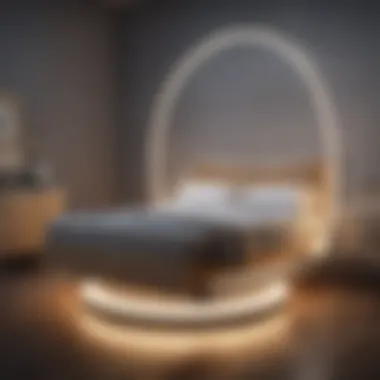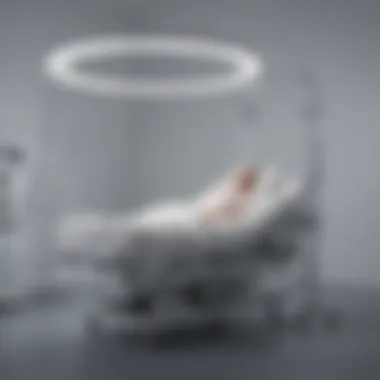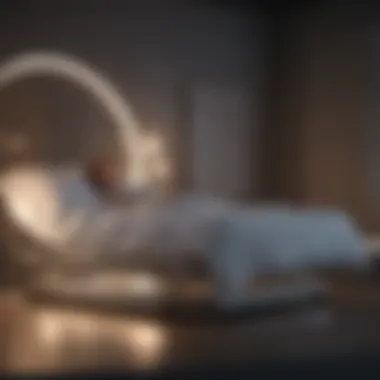Rotating Beds: A New Approach for Spinal Cord Care


Intro
The advancement of medical technology is crafting new avenues in the management of spinal cord injuries (SCI), with rotating beds emerging as a particularly intriguing option. The concept behind these innovative beds involves a mechanical design that turns patients systematically, promoting better circulation, preventing bedsores, and enhancing overall well-being. While traditional medical practices focus on rehabilitation through stationary treatment, rotating beds introduce a dynamic element that mirrors more natural movements. This dynamic motion could play a vital role not just in physical rehabilitation but also in the psychological aspects of recovery.
As we navigate through this exploration, it is essential to clarify certain terms and concepts that will frame our understanding of this topic. Rotating beds are not mere enhancements to existing patient care but rather represent a paradigm shift, combining technology and therapeutic practices in ways previously unthought of.
Key Concepts and Terminology
Definition of Key Terms
To fully grasp the implications and benefits of rotating beds, some key terms must be defined:
- Spinal Cord Injury (SCI): An injury to the spinal cord that can result in a loss of mobility, sensation, or bodily functions below the site of injury.
- Rotating Bed: A specially designed bed that allows freedom of movement, usually incorporating a mechanism that rotates or tilts the patient gently and regularly.
- Pressure Ulcers: Injuries to the skin and underlying tissue that occur when pressure on the skin prevents blood flow.
- Rehabilitation: A set of interventions designed to optimize functioning and reduce disability in individuals with health conditions in interaction with their environment.
Concepts Explored in the Article
This article delves into:
- The mechanical design and features of rotating beds.
- The therapeutic benefits associated with regular rotation, especially for those with compromised mobility.
- Real-life experiences shared by users, caregivers, and health professionals.
- The clinical implications of implementing rotating beds in healthcare settings.
- The challenges and limitations of this technology, as well as potential areas for future research.
Findings and Discussion
Main Findings
Research has shown that rotating beds can significantly reduce the risk of pressure ulcers by promoting blood flow and alleviating pressure points. The consistent movement aids in relaxing muscle tension, making it easier for individuals to adopt a more comfortable position. Moreover, anecdotal evidence points to psychological benefits, such as improved mood and reduced feelings of isolation among patients, thanks to enhanced interaction capabilities while lying down.
In addition, a recent study reported that 68% of users stated improvements in their overall quality of life due to the integration of rotating beds during recovery. Such findings point to a positive correlation between innovative technologies and rehabilitation effectiveness.
Potential Areas for Future Research
While current findings are promising, certain areas require further exploration:
- The long-term efficacy of rotating beds on various types of spinal cord injuries.
- Cost-effectiveness analysis of integrating rotating beds into hospital settings versus traditional care options.
- User experience studies focused on the psychological impacts of prolonged use.
- Specific adaptations aimed at different patient demographics, including age or type of injury.
In sum, the engagement with rotating beds reveals a complex landscape of opportunity and consideration. As therapies continue to evolve, understanding how these devices fit into the larger picture of spinal cord injury management is crucial, enhancing not only recovery but also the overall experience of those affected.
Prelude to Rotating Beds
In recent years, the conversation around medical equipment for patients with disabilities has expanded to include innovative solutions like rotating beds. These beds are not just a luxury; they are becoming paramount in the management of spinal cord injuries. Why, you may wonder? The way these beds function can lead to significant improvements in patient care. They allow for gentle repositioning of individuals unable to move independently, offering numerous benefits such as reducing pressure sores, enhancing circulation, and even improving overall comfort.
With spinal cord injuries, challenges can be daunting. Patients often face long-term consequences that hinder their mobility and quality of life. Therefore, the role of specialized equipment like rotating beds becomes crucial. These devices can offer a more dynamic alternative to traditional static beds, addressing important aspects of patient health and comfort.
Understanding Spinal Cord Injury
Spinal cord injuries can stem from a variety of causes, including trauma, disease, or congenital defects. The spine is a delicate structure, protecting the spinal cord, which is the communication highway for messages between the brain and the body. When this connection is disrupted, the effects can range from temporary dysfunction to permanent paralysis.
The nature of the injury can influence treatment and management. In many cases, patients require long-term care and assistance. This is where advanced medical beds come into play. They can help mitigate complications associated with immobilization, thereby playing a vital role in rehabilitation efforts.
Evolution of Medical Beds
The journey of medical beds from simple wooden frames to sophisticated rotating designs is fascinating. Historically, medical beds were primarily utilitarian—basic structures designed to support patients in need. However, the advent of technology has led to significant advances in their design and functionality.
Traditional hospital beds lacked the smart features that are available today. The introduction of electrically adjustable beds marked a turning point, allowing caregivers to adjust the height or position of the patient with ease. The progression didn't stop there, as innovators recognized the need for beds that could actively reposition patients with minimal intervention. Instead of simply adjusting height and angle, rotating beds were designed to offer 360-degree movement.
"The evolution of medical beds has fundamentally transformed patient care, giving a voice to the voiceless in their own recovery."
With rotating mechanisms, modern beds provide a much-needed solution for individuals with limited mobility. This adaptation highlights the intersection of technology and patient-centered care, ensuring that comfort and health are mutually inclusive.
As we delve further into the mechanics and benefits of rotating beds, it is clear that understanding both spinal cord injuries and the evolution of medical beds lays a solid foundation for appreciating the innovation that exists in this sector. The conversation surrounding these advanced beds is not merely about comfort; it encompasses a larger narrative about recovery, autonomy, and an overall enhancement of quality of life.


Mechanics Behind Rotating Beds
The mechanics of rotating beds play a crucial role in their function. Their design and operation directly influence treatment outcomes for individuals with spinal cord injuries. By understanding the mechanics, we can better appreciate the therapeutic benefits these beds offer, as well as any challenges that may arise in their use.
Design Features
Rotating beds have multiple design features that address the needs of patients suffering from spinal cord injuries. Here's a breakdown of the key elements:
- Adjustable Frame: The frame can accommodate various mattress types. This adaptability is important for ensuring proper support and comfort.
- Rotational Mechanism: Models like the RoboBed or TurnAround Bed often use advanced technology to achieve rotation with minimal noise. This quiet operation is beneficial in calming patients, especially during nighttime.
- Safety Features: Integrated guardrails and non-slip surfaces make getting in and out of bed safer. This consideration is paramount as many patients may have impaired mobility or sensation.
- Pressure Relief Systems: Some beds incorporate air-filled compartments to help distribute weight evenly. This design helps reduce the risk of pressure ulcers, a major concern for individuals with limited mobility.
These features not only enhance the user experience but also align with the rehabilitation goals of promoting comfort and allowing for easier care.
Operational Mechanisms
Understanding the operational mechanics of rotating beds is essential for efficient use. The following outlines how these beds function:
- Motorized Rotation: Most models have an electric motor that facilitates the bed's ability to rotate. This motor can be programmed to rotate at specific intervals, greatly reducing the physical strain on caregivers.
- User-Controlled Features: Many rotating beds come with remote controls or smartphone applications. This functionality allows patients or caregivers to customize the rotation speed and degree of tilt to suit individual comfort needs.
- Integration with Other Therapies: Modern rotating beds can often complement other therapeutic tools, such as positioning cushions or physical therapy devices. This synergy can enhance the overall rehabilitation process.
"The efficiency of a rotating bed should not just be measured by its technology, but by its ability to adapt to the needs of each patient," says a leading researcher in spinal injury rehabilitation.
These operational aspects not only improve the handling of patients but also empower them by offering some level of independence, which is invaluable in their recovery journey.
Therapeutic Benefits
Understanding the therapeutic benefits of rotating beds is crucial for grasping their potential impact within the realm of spinal cord injury management. These beds are not merely innovative in design; they serve critical functions that can significantly improve user outcomes. With a focus on aspects like pressure relief, circulation improvement, and enhanced mobility, the essence of why rotating beds matter becomes clear.
Pressure Relief
Pressure sore, also known as decubitus ulcers, can occur when individuals are confined to a single position for extended periods. This can be particularly troublesome for those with spinal cord injuries. Rotating beds tackle this issue head-on by facilitating continuous movement.
- Dynamic Shifting: By automatically rotating or tilting, these beds keep pressure points from settling. The movement can reduce the risk of localized tissue damage, a common plight for bed-bound individuals.
- Comfort Factor: Patients often report feeling a greater sense of comfort since the consistent change in position alleviates the discomfort associated with prolonged pressure on specific areas.
- Clinical Evidence: A notable study illustrated that patients using rotating beds experienced a 30% drop in pressure ulcers compared to those on standard hospital beds.
In essence, the ability of these beds to relieve pressure is not just about comfort; it's a vital component in preventative care that enhances the overall quality of life for individuals facing mobility challenges.
Improving Circulation
Circulation, particularly in immobilized individuals, is yet another crucial area where rotating beds make a difference. Prolonged immobility can lead to blood flow restrictions, forming a potentially hazardous situation, including deep vein thrombosis.
- Blood Flow Optimization: The shifting motion of the bed helps promote better blood flow in limbs. This is essential in aiding nutrient delivery and waste removal, ultimately fostering overall health.
- Long-Term Benefits: Improved circulation can lessen swelling and pain, hastening recovery during both hospital stays and rehabilitation processes. Regular movement keeps the vascular system active.
- Adaptive Responses: As the body adjusts to these changes, some report an improved sense of vitality and alertness, which can benefit their rehabilitation journey.
Clearly, the role of these beds in enhancing circulation is multi-faceted, providing both immediate comfort and long-term health advantages.
Enhanced Mobility
Enhanced mobility may sound paradoxical when discussing beds; however, it speaks to the transformative role these devices can play. For individuals with spinal cord injuries, gaining any semblance of independence is paramount.
- Functional Training: When using a rotating bed, users can engage in various supportive therapies that encourage movement patterns mimicking daily activities. This can be a stepping stone towards more complex rehabilitation.
- Mental Health Benefits: Having the chance to shift around autonomously—even just in bed—helps boost self-esteem and decreases feelings of helplessness. The psychological aspects shouldn’t be overlooked, as they can significantly impact healing.
- Holistic Recovery: Consequently, the variability in positioning allows for a holistic approach to recovery, as patients can more easily participate in therapy sessions designed to improve their overall physical capabilities.
Through these therapeutic benefits, it becomes evident that rotating beds offer much more than merely a resting place; they provide an environment conducive to improving the well-being and functional potential of individuals facing the challenges of spinal cord injuries.
"The only real mistake is the one from which we learn nothing."
In wrapping up this section on therapeutic benefits, the multifaceted advantages of rotating beds emerge clearly—serving as a valuable asset for anyone involved in managing spinal health.
Clinical Applications
The utilization of rotating beds in spinal cord injury management marks a significant advancement in patient care across various clinical contexts. These specialized beds serve as both a therapeutic tool and a means of enhancing overall patient outcomes. Their application extends beyond the confines of hospital walls, integrating into different stages of care, from acute hospital settings to rehabilitation centers and home care scenarios. Understanding these clinical applications can provide insight into their benefits and the considerations necessary for effective use.
Hospital Settings


In hospital environments, rotating beds offer a critical solution for individuals with severe mobility limitations. The need for effective pressure relief and circulation enhancement cannot be overstated; rotating beds facilitate patient repositioning without requiring manual intervention from nursing staff, thus reducing physical strain on caregivers. Hospitals can experience a decrease in the incidence of pressure ulcers, which are notoriously prevalent in patients with limited mobility.
From a logistical standpoint, rotating beds are highly beneficial in Intensive Care Units (ICUs), where patients often require prolonged bed rest. The automated rotation helps maintain skin integrity while allowing for the continuous monitoring of vital signs and overall health. Furthermore, studies have indicated that these beds can reduce hospital stays for spinal cord injury patients, ultimately minimizing healthcare costs and freeing up valuable resources.
Rehabilitation Centers
Rehabilitation centers focus on restoring functionality and improving the quality of life for patients recovering from spinal cord injuries. Rotating beds play an instrumental role in this setting by promoting active participation in their recovery process. With their ability to adjust the patient's position automatically, these beds encourage mobility, which is essential for physical and emotional well-being.
Patients can engage in a range of therapeutic exercises while on a rotating bed, benefiting from improved blood circulation and muscle activation. Additionally, the presence of these innovative beds may enhance the therapeutic relationship between patients and caregivers, fostering a supportive environment that encourages engagement in rehabilitation activities. The focus, however, should also be on training staff to effectively utilize the technology to maximize its benefits within the rehabilitation process.
Home Care Scenarios
The transition from hospital to home can be a daunting experience for many patients, particularly those with spinal cord injuries. Rotating beds can be a game-changer in home care scenarios. Equipped with functionalities that allow for ease of use by patients or caregivers, they can significantly enhance independence and comfort at home.
Implementing a rotating bed in a home care setting allows families to provide better quality care without risking their physical well-being. For instance, the ease of repositioning becomes invaluable for family members who may lack the training or strength for safe manual handling.
Moreover, the emotional aspect of returning home cannot be overlooked. Having a rotating bed can imbue a sense of normalcy and control in one’s environment, contributing positively to mental health during recovery.
"The impact of a rotating bed on a patient’s psychological well-being should not be underestimated. It often fosters a sense of autonomy while alleviating caregiver burdens."
User Perspectives
In discussions about medical innovations, understanding the user perspectives can be crucial. This section emphasizes how feedback from patients and insights from caregivers shine a light on the practical implications of using rotating beds for spinal cord injury management. User experiences not only inform design improvements but also help gauge the broader impact this technology has on daily living and recovery processes.
Patient Feedback
A significant aspect of evaluating rotating beds is the direct input from patients. Their feedback serves as a touchstone for progress in both comfort and effectiveness. Many individuals with spinal cord injuries express mixed feelings based on personal circumstances and the technology’s adaptability to their needs. For instance, a patient named Linda, who suffered a spinal injury from a car accident, reported feeling more comfortable and less anxious during the night when using a rotating bed.
Patients often highlight specific features that enhance their experience, such as:
- Adjustable rotation angles: Allowing them to find a position that alleviates pressure points.
- Easy controls: Simplifying the process of bed adjustments, so patients can make changes without needing assistance.
- Integration with care routines: Many find that these beds complement physical therapy sessions, promoting better alignment of their spine.
Moreover, anecdotal evidence suggests that some have experienced better sleep quality and a notable decrease in pressure sores. However, it’s equally important to acknowledge the challenges some patients face, such as feelings of vulnerability when shifting positions. These sentiments can offer valuable insights into how the design can evolve.
"With this rotating bed, I can finally sleep more soundly. The gentle shifts really make a difference!" – John, a patient receiving care.
Caregiver Insights
Caregivers, often the unsung heroes in a patient’s recovery journey, also provide profound insights. They observe day-to-day interactions and can highlight the practicalities that family members might overlook. Caregivers often appreciate how rotating beds contribute to reducing their workload. These beds can ease the physical strain that comes with repositioning patients, allowing caregivers to focus on other essential aspects, like emotional support or accompanying the patient during therapy.
Some standout observations shared by caregivers include:
- Less fatigue: Regular shifts can prevent both patients and caregivers from becoming too exhausted.
- Improved interaction: As the patient feels more at ease physically, caregivers notice enhanced engagement and communication.
- Versatility: Many have noted that these beds can adapt to various home environments, making them suitable for both hospitals and home care setups.
Yet, caregivers have also pointed out some limitations. Familiarizing themselves with the technology requires time, especially when operating more advanced features. For instance, a caregiver named Maria remarked on the steeper learning curve associated with high-tech rotating beds, underscoring the need for user-friendly designs.
Thus, listening to both patient feedback and caregiver insights creates a more comprehensive view of how rotating beds can integrate into spinal cord injury management effectively. This understanding could ultimately guide future projects and improvements, ensuring that the needs of both parties are well addressed.
Challenges and Limitations
Understanding the challenges and limitations associated with rotating beds is crucial for grasping their overall impact on spinal cord injury management. While these innovative devices offer significant benefits, it's equally important to acknowledge the practical hurdles that may hinder their widespread adoption and effectiveness. This section delves into the key issues, outlining various concerns like cost and accessibility, technical limitations, and user adaptation that can play a pivotal role in the success of rotating beds in therapeutic settings.
Cost and Accessibility
One of the most pressing concerns regarding rotating beds is the financial aspect. These beds can come with a hefty price tag, often several thousands of dollars. For many healthcare facilities, especially smaller hospitals or rehabilitation centers, affording such a device may pose a formidable challenge. With budgets often tight, allocating funds for premium equipment can lead to tough choices.
Not only do facilities need to consider the initial purchase cost, but ongoing maintenance and operational costs can add to the financial burden. Furthermore, insurance coverage for rotating beds is inconsistent, which creates barriers for patients seeking these advanced options.
Accessibility is another significant factor. Residents of rural areas may have to travel long distances to access care centers equipped with rotating beds, thus exacerbating treatment delays. Even with the increasing interest in these devices, their availability may not match the pressing needs of patients.


“Cost shouldn’t be a barrier to innovative treatment,” highlights a healthcare professional.
Technical Limitations
Despite their benefits, rotating beds are not without technical limitations. For example, the complexity of the mechanisms involved in rotating beds can lead to potential malfunctions or breakdowns. Any technological failure can disrupt the therapeutic process and cause setbacks in a patient's rehabilitation journey. Additionally, not all rotating beds are designed to accommodate every patient's personal needs. Factors like body size, weight distribution, and the severity of injury can impose constraints on how effectively a bed operates for an individual.
Moreover, integrating rotating beds into existing hospital equipment and systems can be a logistical challenge. Staff training is essential to ensure that all caregiver personnel are adept in utilizing these beds effectively. Without proper training, staff members may hesitate to use the equipment, limiting its potential benefits for patients.
User Adaptation
Adapting to a rotating bed can be a transition for both patients and caregivers alike. For patients with spinal cord injuries, shifting to a new type of bed requires physical and psychological adjustment. The sensation of rotating, while potentially beneficial, can be disorienting for some individuals. Encouraging comfort with this novel technology involves careful orientation and ongoing support from healthcare providers.
Additionally, caregivers may also face initial reservations regarding the effectiveness of rotating beds. Some may question whether these devices deliver the promised therapeutic benefits compared to traditional methods. Hence, clear communication about the advantages, along with firsthand training, is critical to foster trust and acceptance in the new system.
In summary, addressing the challenges and limitations of rotating beds is essential for anyone involved in spinal cord injury management. Recognizing the cost implications, technical hurdles, and the need for user adaptation offers a more balanced perspective on integrating these advanced solutions into therapeutic practices.
Future Perspectives
In recent years, the application of rotating beds has gained attention in the field of spinal cord injury management. As technology progresses at an alarming rate, the innovations around these therapeutic beds present crucial prospects. The focus is on refining designs that are not only effective but are also user-friendly and accessible for a broad spectrum of patients. This section will explore the importance of innovative designs and the research directions that can change the landscape of spinal care and rehabilitation.
Innovative Designs
There is no denying that the effectiveness of rotating beds lies in their sophisticated design. Modern versions are often tailored with technology that tracks users' movements and vitals. For instance, some beds come equipped with pressure sensors that can automatically adjust position to mitigate pressure sores. However, the future holds even more exciting possibilities.
Imagining beds made from lightweight, durable materials that can easily conform to a patient's body is not far-fetched. 3D printing may advance to a point where custom molds are created based on individual patient needs, allowing for a more personalized approach to spinal rehabilitation.
Incorporating smart technology enhances functionality significantly. Beds that integrate with mobile devices could permit caregivers and patients to set preferences or receive alerts concerning health status. Moreover, the potential for artificial intelligence to analyze data over time could lead to optimized care strategies tailored to individual recovery patterns.
Benefits of Innovative Designs:
- Customization: Tailoring beds to specific needs promotes a higher quality of care.
- User Comfort: Improved ergonomics can minimize discomfort and enhance the rehabilitation experience.
- Data Integration: Smart beds can drive data collection that informs better treatment plans.
- Market Accessibility: As new materials and technologies are developed, costs may decrease, making these beds more widely available.
Research Directions
Future studies in the realm of rotating beds should encompass a variety of areas, particularly focusing on technological advancements and their effects on recovery. Collaborative research involving medical professionals, engineers, and patients can catalyze innovations.
Current gaps in research need attention, especially related to long-term effects and comparative analysis with traditional immobilization methods. It would be beneficial to conduct randomized controlled trials that measure the outcomes of patients using rotating beds against those on standard beds.
Moreover, exploring the psychological effects of rotating beds is an area that remains under-discussed. Studies could investigate how the dynamic nature of such beds impacts patients' motivation and emotional well-being during recovery.
In addition, considering the growing interest in telemedicine, integrating rotating beds with remote monitoring could be groundbreaking. This would allow healthcare providers to keep a closer eye on a patient's progress, making adjustments in care as necessary.
"The convergence of technology and healthcare in spinal injury management heralds a new era of patient care experiences that are more tailored and effective."
Potential areas of research include:
- Longitudinal studies inspecting the therapeutic benefits over time.
- Patient satisfaction metrics regarding design and functionality.
- Evaluating caregiver ease of use and training requirements.
Ending
The exploration of rotating beds for managing spinal cord injuries reveals a salient intersection of technology and patient care. These specialized beds serve not just as furniture but as vital tools that can substantially impact health outcomes for individuals facing debilitating conditions. A careful examination of the findings presented throughout this article underscores the manifold benefits these beds provide, along with some considerations for their broader implementation in various healthcare settings.
Summarizing Key Findings
Rotating beds are designed to perform a critical role in the recovery process for spinal cord injury patients. Some of the most significant findings include:
- Dynamic Movement: The capability of rotating beds to periodically shift the patient’s position helps alleviate pressure on vulnerable skin areas, mitigating the risk of pressure sores.
- Enhanced Blood Flow: By promoting changes in position, these beds directly support better blood circulation, which is crucial for healing and overall health.
- Improved Comfort: Many patients report feeling more comfortable and secure, as these beds facilitate easier transfers and adjustability that cater to individual needs.
- Clinical Versatility: From hospital environments to rehabilitation centers, the rotating bed's design allows for its efficient use across different scenarios, including home care setups.
Given these strengths, it's clear why the interest in rotating beds has surged—and it begs the question: how can these innovations be made accessible to more patients in need?
The Importance of Continued Research
While the current findings are promising, the landscape of spinal care is ever-evolving. Ongoing research is vital to ensure that rotating beds can be optimized for an even wider range of conditions and preferences. Here are a few points to consider for future research directions:
- User-Centric Design: Investigating how these beds can be tailored to fit various body types, activity levels, and personal preferences is crucial. Involving patients in the design process could lead to significant improvements.
- Data-Driven Insights: Gathering extensive usage data can help healthcare professionals understand better how rotating beds impact health outcomes over the long term.
- Cost-Benefit Analyses: Analyzing the long-term financial implications of implementing rotating beds in various care settings could promote their broader adoption by clarifying their role in improving recovery times and reducing complications.
In summary, the insights from this article illuminate not just the current capabilities of rotating beds but also pave the way for a future where continuous research and development can further enhance spinal cord injury management. Engaging the medical community, researchers, and patients in this dialogue will be essential to maximize the potential these beds hold for transforming lives.







